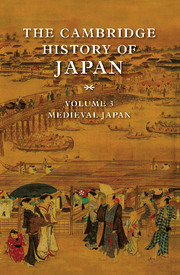Book contents
- Frontmatter
- Introduction
- 1 The Kamakura bakufu
- 2 Medieval shōen
- 3 The decline of the Kamakura bakufu
- 4 The Muromachi bakufu
- 5 Muromachi local government: shugo and kokujin
- 6 The decline of the shōen system
- 7 The medieval peasant
- 8 The growth of commerce in medieval Japan
- 9 Japan and East Asia
- 10 CULTURAL LIFE IN MEDIEVAL JAPAN
- 11 The other side of culture in medieval Japan
- 12 Buddhism in the Kamakura period
- 13 Zen and the gozan
- Works cited
- Glossary
- Index
- References
11 - The other side of culture in medieval Japan
Published online by Cambridge University Press: 28 March 2008
- Frontmatter
- Introduction
- 1 The Kamakura bakufu
- 2 Medieval shōen
- 3 The decline of the Kamakura bakufu
- 4 The Muromachi bakufu
- 5 Muromachi local government: shugo and kokujin
- 6 The decline of the shōen system
- 7 The medieval peasant
- 8 The growth of commerce in medieval Japan
- 9 Japan and East Asia
- 10 CULTURAL LIFE IN MEDIEVAL JAPAN
- 11 The other side of culture in medieval Japan
- 12 Buddhism in the Kamakura period
- 13 Zen and the gozan
- Works cited
- Glossary
- Index
- References
Summary
HISTORIOGRAPHICAL ISSUES
Historians transform lived life into narrated life, and in this sense they are not unlike novelists. Intent notwithstanding, neither history nor novel copies human experience but, rather, selects, focuses, and retells and thereby inevitably reshapes. Even subtraction adds something new. And so though we go to both historians and novelists for “truth,” both are inherently disposed to falsification.
By selecting and subtracting, the interpretations of Japanese cultural history to date, particularly those of the Kamakura and Muromachi eras (roughly the twelfth through the sixteenth centuries) have focused on the “high” culture of the period; on the activities of the political, religious, and intellectual leaders of the time; and on the achievements of their close associates, eminent artists, architects, writers, and performers. Even those historians who are interested in the culture of ordinary people tend to view them in comparison with the upper classes, and their accounts are thereby riveted to the same high-low polarity as are those of the historians with whom they are ideologically at odds. Ironically, therefore, an elite veneer stretches over the history of the middle ages, obscuring the texture and contours of the daily life of the great majority of medieval men and women, while leaving in darkness those creators of Japanese culture who have failed to qualify under these preferred definitions of history.
It is not that such lives are beyond historical retrieval. On the contrary, throughout the middle ages the daily life of ordinary citizens was often a subject of note, even in the diaries and historical records of the elite; it is therefore much more easily resurrected than might be imagined.
- Type
- Chapter
- Information
- The Cambridge History of Japan , pp. 500 - 543Publisher: Cambridge University PressPrint publication year: 1990
References
- 5
- Cited by



